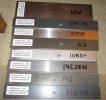Is Luong another scientist that makes knives? Or does he just make knives?
Would he need to the science behind the process in in experiments with HT? Theoretical versus experimental probability without the theory?
I just try to understand what I can. All very interesting, discussion, mystery and all.
Would he need to the science behind the process in in experiments with HT? Theoretical versus experimental probability without the theory?
I just try to understand what I can. All very interesting, discussion, mystery and all.



